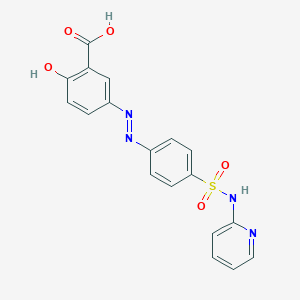Crohn's disease
Adult: For active cases, especially in the colon: Initially, 1,000-2,000 mg 4 times daily until remission occurs. May be given with corticosteroids, if necessary. Overnight interval between doses must not exceed 8 hours. Adjust dose according to the severity of the disease, patient response and tolerance. Dosage recommendation may vary among individual products or between countries (refer to detailed product guideline).
Child: ≥2 years For active cases, especially in the colon: 40-60 mg/kg daily in divided doses.
Child: ≥2 years For active cases, especially in the colon: 40-60 mg/kg daily in divided doses.
Oral
Rheumatoid arthritis
Adult: In patients who respond inadequately to salicylates or NSAIDs: As enteric-coated or delayed-release tab: Initially, 500 mg daily for the 1st week, then increased by 500 mg every week to 2,000-3,000 mg daily in divided doses according to patient response and tolerance. Max: 3,000 mg daily in 2-4 divided doses. Dosage recommendation may vary among individual products or between countries (refer to detailed product guideline).
Oral
Ulcerative colitis
Adult: Mild to moderate and severe acute attacks: Initially, 1,000-2,000 mg 4 times daily until remission occurs. May be given with corticosteroids, if necessary. Alternatively, initial dose of 3,000-4,000 mg daily in evenly divided doses, or may initiate with 1,000-2,000 mg daily to decrease gastrointestinal intolerance. Overnight interval between doses must not exceed 8 hours. Maintenance of remission: Reduce dose gradually to 2,000 mg daily in divided doses. Adjust dose according to the severity of the disease, patient response and tolerance. Dosage recommendation may vary among individual products or between countries (refer to detailed product guideline).
Child: ≥2 years Acute attacks: 40-60 mg/kg daily in divided doses. Maintenance of remission: 20-30 mg/kg daily in divided doses.
Child: ≥2 years Acute attacks: 40-60 mg/kg daily in divided doses. Maintenance of remission: 20-30 mg/kg daily in divided doses.
Oral
Polyarticular juvenile rheumatoid arthritis
Child: In patients who responded inadequately to salicylates or other NSAIDs: ≥6 years As enteric-coated or delayed-release tab: 30-50 mg/kg daily in 2 evenly divided doses. Max: 2,000 mg daily. To decrease gastrointestinal intolerance, begin therapy with 1/4 to 1/3 of the planned maintenance dose and increase weekly to reach maintenance dose in 1 month.
Rectal
Crohn's disease
Adult: For active cases: As supp: Initially, 1,000 mg in the morning and at night after defecation. After 3 weeks, dosage may be gradually reduced according to the severity of the disease, patient response and tolerance.
Rectal
Ulcerative colitis
Adult: As supp: Acute attack: Initially, 1,000 mg in the morning and at night after defecation. After 3 weeks, dosage may be gradually reduced according to the severity of the disease, patient response and tolerance. For severe generalised cases of the rectum or recto-sigmoid, or those who respond slowly to oral therapy: 500-1,000 mg in the morning and at night may be given as an adjunct to oral treatment.




 Sign Out
Sign Out




